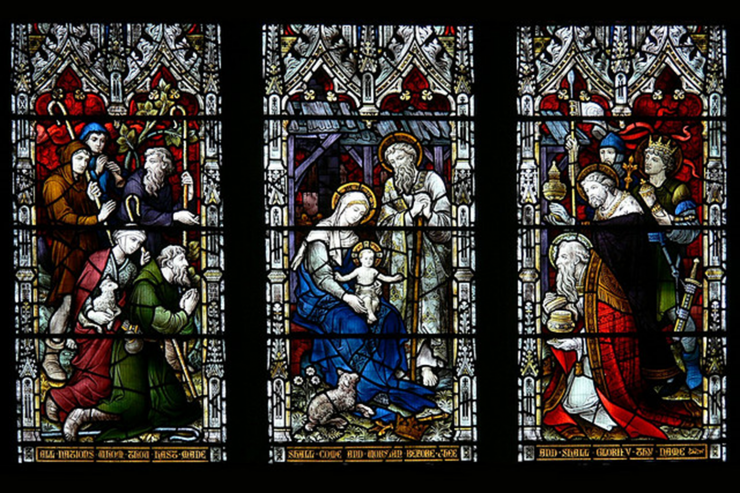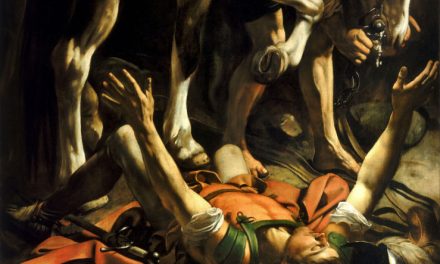Reading the Holy Scriptures in the modern age is a more daunting task than might be supposed considering the cacophony of educators cheerleading for the false success of a wholly corrupted educational system. The modern school promotes a false sense of literacy more transparent than the Emperor’s new clothes when held up to time honored understandings of literacy and the light of Truth emanating from Holy Mother Church.
The great teachers throughout history, particularly the Church Doctors, will confirm that literacy, especially biblical literacy, is not simply a matter of decoding letters and gleaning basic information from a sequence of words and sentences, but an organic process of hearing with the human heart what is written upon it. If we refer to the Catechism for instruction on how to properly read the Scriptures, a proper reading of David and Goliath may help us to catch a glimpse of the depth of the Gospel message and how deep the scriptures plumb to convey the entirety of Salvation History, the unfolding and unpacking of the single word of God, the Logos. For what are the Holy Scriptures but an explanation of the Holy Word of God?
In Her unfathomable wisdom, Holy Mother Church gives us Catholics a touchstone by which to recover a true sense of literacy in the most important domain that liberating art occupies, that of interpreting the Holy Scriptures. In the Dogmatic Constitution on Divine Revelation Dei Verbum, it is suggested that the soul who would like to properly read, interpret and understand Sacred Scripture “should carefully investigate what meaning the sacred writers really intended, and what God wanted to manifest by means of their words.”When it comes to truly being edified by the inerrant word of God, the foundational and most central truth to understand is that the Holy Spirit is the “interpreter of Holy Scripture,” not us.
The Catechism reiterates the profound teaching in Dei Verbum by laying out for us three rules that must be observed as foundational principles to reading the Bible “in accordance with the Spirit who inspired it.”In the first rule, paragraph 112 of the Catechism tells us to observe with the utmost strictness that the entirety of the Scriptures from the first word of Genesis to the last word of Revelation. Every word from first to last has a unity and consistency of content that excludes any contradictions. It is common practice today to try to search out apparent contradictions in the Biblical texts. Surely, many apparent contradictions have been found and held out for examination, but upon deeper understanding, all contradictions are proven illusory. All of the Holy Scriptures emanate from Christ’s Sacred Heart illustrating the unity of God’s salvific plan and such unity is revealed in the Holy Scriptures when they are properly interpreted.
The second rule in paragraph 113 is that we must read the Bible within “the living Tradition of the whole Church.” Such is our reliance on the written word today that we overlook the truth that Sacred Scripture is written on the heart of the Church in the same way that God’s law is written on our hearts. The written works and archives are pale imitations incapable of transmitting God’s truths to us with the same organic fluidity as our teachers, the Church Doctors, who properly convey the sacred Traditions of Holy Mother Church. We must turn to those great teachers instead of to ourselves if we are to properly understand what we are reading.
Finally, the third rule in paragraph 114 explains that we must be attentive to the “analogy of faith.” By this the Catechism means “the coherence of the truths of faith among themselves and within the whole plan of Revelation.” The Analogy of Faith is the assurance that Scripture will not contradict itself. This demonstrates the harmonic and immutable teaching contained in the entirety of the Bible. In the early Church there were no hermeneutics to assist folks in interpreting the Scriptures, so Tradition and the Analogy of Faith were the two dominant laws of interpretation.
If we begin by adhering to these three rules we will begin to become ready, by the graces of the Holy Spirit, to interpret the breadth of Sacred Scripture as it was intended for us. Next it is in our best interest to become aware of the four senses of Scripture that help us to plumb the depths of the Bible’s meaning to begin to glean the fullness of the Gospel Message.
The Catechism explains that there are two distinct senses of Scripture, the literal and the spiritual. The spiritual sense is subdivided into three senses; the allegorical, moral and anagogical senses. All together, these make four distinct senses to which the Holy Scriptures speak. These four senses demand our attention, sustained contemplation and arduous study if we are to begin to plumb the depths of God’s scriptural revelation.
Paragraph 116 explains that the single literal sense of Scripture has its meaning “conveyed by the words of Scripture and discovered by exegesis, following the rules of sound interpretation: all other senses of Sacred Scripture are based on the literal.” To obtain the deepest understanding of the Scriptures, it is important to realize that all four senses are in perfect accordance with one another. We are prone in this age to consider that the first literal sense of reading signals the depth of our understanding. But just like seeing a human body tells you very little about a particular human soul, a literal reading the Bible offers no real hope of understanding the full breadth and depth of the Good news our Heavenly Father intended for us by the gift of the Holy Scriptures.
As to the three subdivisions of the spiritual sense of biblical interpretation, Paragraph 117 of the Catechism explains that by the allegorical sense that we can obtain a deeper understanding of a particular set of events by realizing its reference to Christ and the Gospel Message. By the moral sense, we can discover how a particular narrative is personal instruction on how we ought to conduct ourselves in accordance with divine justice. In the anagogical sense we can begin to see the events narrated in the Bible “in terms of their eternal significance, leading us toward our true homeland: thus the Church on earth is a sign of the heavenly Jerusalem.” Augustine of Dacia, a mediaeval poet left is this couplet that summarizes the four senses:
“The Letter speaks of deeds; Allegory to faith;
The Moral how to act; Anagogy our destiny.”
The story of David and Goliath which appears in 1 Samuel chapter 17 is perhaps the most well-known and beloved story in the Old Testament. But for this reason it may also be the easiest story to leave unexplored much beyond the literal sense of understanding. With the above instructions in mind we turn to the story of David and Goliath to examine the four senses in order to plumb the depths of the Gospel message most succinctly expounded by the Kerygma proclamation.
On the literal level of the David and Goliath story, we learn the history of the house of Jesse of Bethlehem who was the son of Obed and grandson of Boaz and Ruth. This is the family root and line of our Lord and Savior Jesus Christ. David’s faith in God to grant him victory against seemingly impossible odds is captivating. The riveting details of this timeless tale told simply in the first literal sense make it a worthwhile story. However, that would be analogous to judging a book by its cover when we go further to examine the story in light of the three spiritual senses, those of the allegorical, moral, and anagogical.
Historically the story begins during the reign of King Saul who brought the children of Israel into the Valley of the Terebinth to set up for war against the Philistines. The Israelites were on a mountain on one side of the valley and the Philistines were on a mountain on the other. As the two camps prepared and waited for the battle, every day the giant Goliath would insultingly call out to anyone in Israel’s army to meet him in single combat, but fear insured there were no takers.
Our hero David came from the house of Jesse. While Jesse had his three eldest sons out of eight on the battle field, his youngest son David was home shepherding the flocks. One day Jesse sent David the front to take his brothers refreshment and to bring back news of the fight. While David was there he heard the giant’s insults to the army of the living God. He took up arms against the giant foe, and by the grace of God was triumphant.
We can concede that the literal sense alone is compelling, but for the edification of our souls, we must go deeper. Concerning the allegorical sense, David is a type for Christ. In the beginning we learn that David was shepherding the flock and that when one was stolen away by the lion or the bear, David would go after the beast, kill it and return the sheep to the flock. This is just as Christ is our shepherd and if one goes astray, He will leave 99 to bring the lost one back into the fold.
Of deep significance is the fact that Goliath came out in front of the army of the living God for 40 consecutive days before David finally answered the call. This echoes the 40 years the Chosen People wandered in the desert and prefigures Christ’s 40 days in the wilderness as He prepared for the spiritual combat that awaits us all.
The fact that the entire Israeli army was paralyzed by fear and could not answer the challenge signals the difficulty we may have in accepting the call to combat against such daunting odds. Even King Saul told David he was too small to take on the giant, just as those around us might discourage us from taking up arms against a corrupted world and its demonic influence because it seems too big to overcome. David’s combat with the giant is an allegory for the spiritual combat to which all souls are called.
In the moral sense we are instructed on how we ought to comport ourselves in the spiritual combat. We must face our fallen nature, the world and Satan as David faced the giant. David illustrates that we are to confront evil in such a way as to strike it a mortal blow. We learn from David that we ought to use our God given talents and cooperate with grace to achieve our victory. When David was given Saul’s armor he chose to leave it off because his talent was with the sling and stone.
We can learn from the story of David and Goliath that God provides everything we need to overcome sin, it is left to our courage and the free will choice to submit our wills to the will of God, a course of action superbly modeled by young David. David ran to the battle, just as we are to make haste to the battle that lies before us. David told the Goliath that he is coming to him in the name of the Lord and that the giant would be delivered into his hand and that he would remove his head from his body. David promised to slay Goliath so that all would know that there is a God in Israel. By the example of David, let us run to the combat in the name of our Lord!
In the anagogical sense, the story of David and Goliath illustrates the triumph of good over evil that is embodied and fulfilled by Christ’s victory over sin, Satan and Death. David’s victory heralds the Lord’s victory in the wilderness and on the cross by the resurrection, that victory that came effortlessly, but seemingly against all odds. The war against evil is over, all that is left is to settle our personal skirmishes as we await the second coming of Christ and the final judgment that will end in either heaven or hell.
Every word of the Old Testament is a thread in the tapestry of Salvation History that illuminates and defines the Kerygma Proclamation. Enabled and enriched by the Holy Spirit we must read the story of David and Goliath as we read all the words of the Holy Scriptures, first by submitting to the fact that the Holy Spirit is the interpreter of Holy Scripture. We must read the BIble by the three rules outlined in the Catechism and be open to the lessons laid out before us and deepened by the four senses of Scripture. All this ought to be reinforced by the traditional interpretations gifted to us by the Church Doctors, Popes and saints who have contributed to the Magisterium of Holy Mother Church. We must gratefully accept and use the many gifts offered to us by grace to begin to discern the deeper meanings and plentiful instructions that await the faithful concerning God’s sacred and inerrant Word revealed by the Holy Scriptures.
If you liked this article, please share it with your friends and family using the Recommend and Social Media buttons below and via email. We value your comments and encourage you to leave your thoughts below. Thank you! – The Editors















